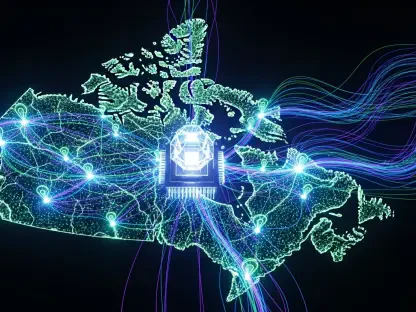In a world where billions of devices connect every second, telecommunications networks are the unseen backbone of modern life, and their management is undergoing a profound shift. What happens when these critical systems, once managed by human hands, are handed over to algorithms that predict failures before they strike? The rise of artificial intelligence in telecoms is not just a technological shift; it’s a seismic change that promises efficiency but challenges the very essence of human oversight. This transformation, unfolding at a breathtaking pace, raises a pivotal question: can machines truly outthink human intuition in an industry where every second of downtime costs millions?
Why AI Is Redefining Telecoms
At the heart of this revolution lies the undeniable importance of seamless communication in today’s digital age. With global data traffic expected to grow by over 25% annually from 2025 to 2027, telecom companies face unprecedented pressure to maintain flawless networks. AI steps in as a powerful ally, tackling issues like network congestion and equipment failures with predictive analytics that can reduce outages by up to 30%, according to recent industry studies. The stakes are high, as even a brief service interruption can erode customer trust and trigger significant financial losses.
Yet, the integration of AI is not merely about preventing problems; it’s about reshaping the industry’s future. From automating customer support with chatbots to optimizing data routing in real-time, AI is becoming indispensable. However, reliance on these tools sparks concern among experts about diminishing the role of human judgment in critical decision-making. Striking a balance between technological innovation and human insight emerges as the central challenge for sustainable progress in this sector.
The Game-Changing Impact of AI Across Industries
Delving deeper, the influence of AI in telecoms reveals a broader trend of transformation across multiple fields. In telecom networks, AI-driven systems analyze vast datasets to reroute traffic dynamically, slashing downtime and boosting efficiency. Beyond this sector, aerospace provides a striking example: AI simulations, supported by advanced platforms, have cut computational fluid dynamics testing from weeks to mere hours, saving millions in traditional wind tunnel expenses.
This efficiency extends to automation and innovation in unexpected ways. In electronic design, conversational AI assistants now aid engineers by streamlining complex workflows, allowing faster prototyping and problem-solving. Data from industry reports highlights that such tools have accelerated project timelines by nearly 20% in some cases. These advancements underscore AI’s role as a catalyst, pushing the boundaries of what’s possible while reshaping operational norms across diverse domains.
The versatility of AI is evident as it adapts to unique industry needs, from telecoms to engineering. It’s not just about speed; it’s about enabling breakthroughs that once seemed out of reach. As algorithms handle repetitive, data-intensive tasks, professionals can focus on strategic goals, amplifying productivity. Yet, this rapid adoption also prompts reflection on how much control should be ceded to machines in high-stakes environments.
Expert Perspectives on AI and Human Synergy
Insights from industry leaders shed light on the delicate interplay between AI’s capabilities and human expertise. Rob Knoth of Cadence Design Systems, speaking at a prominent tech conference, emphasized that while AI simplifies intricate processes, “engineers’ accountability and intuition remain irreplaceable.” His observation points to a cautious optimism, where trust in automated tools grows only through consistent validation against established methods.
This gradual trust-building is crucial, especially in fields like semiconductor design, where precision is paramount. Knoth noted that challenges once believed to require quantum computing are now being addressed by AI, a testament to its unexpected advancements. Such progress evokes awe, yet it also reinforces the necessity of human imagination to contextualize and direct these powerful tools toward meaningful outcomes.
Beyond technical feats, the human element brings a depth that algorithms cannot replicate. Experts argue that while AI excels at processing and prediction, it lacks the creative spark to envision entirely new paradigms. This perspective highlights a symbiotic relationship, where technology amplifies efficiency, but human vision charts the course for groundbreaking innovation in telecoms and beyond.
Strategies for Harmonizing AI and Human Insight
Navigating this evolving landscape requires practical approaches to integrate AI without sidelining human strengths. One effective strategy involves phased adoption, where AI tools are tested alongside traditional methods to build confidence in their reliability. Telecom professionals can start with low-risk applications, such as predictive maintenance, before scaling to more complex network management tasks.
Collaboration also plays a vital role in maintaining balance. Establishing cross-functional teams allows AI to handle data-heavy operations, freeing human experts to tackle creative and strategic challenges. For instance, while algorithms optimize bandwidth allocation, engineers can focus on designing next-generation infrastructure. This division of labor ensures that technology supports, rather than supplants, human ingenuity.
Ethical considerations must guide this integration as well. Setting clear benchmarks for AI deployment ensures alignment with industry standards and societal values. Regular audits of AI decisions can prevent biases and errors, preserving trust in automated systems. By prioritizing transparency and accountability, telecom leaders can harness AI’s potential while safeguarding the moral compass that only human oversight provides.
Practical Steps Following AI’s Rise in Telecoms
Reflecting on this journey, it becomes evident that AI has reshaped telecommunications with unprecedented efficiency, from slashing network downtime to automating customer interactions. The remarkable strides made through predictive analytics and real-time optimization have set a new standard for operational excellence. Yet, the enduring value of human intuition has proven just as vital, guiding ethical considerations and innovative leaps that machines alone couldn’t achieve.
Looking ahead, the path forward demands actionable measures to sustain this balance. Telecom leaders have recognized the need to invest in training programs that equip professionals with skills to collaborate with AI tools effectively. Establishing industry-wide ethical guidelines has also emerged as a priority, ensuring technology serves humanity without overstepping boundaries.
Ultimately, the legacy of this transformation rests on fostering a partnership between AI and human insight. Future progress hinges on nurturing environments where algorithms handle complexity, while people provide vision and empathy. This dual approach has laid the groundwork for telecoms to not only adapt to change but to drive it, ensuring resilience and creativity remain at the core of every advancement.









